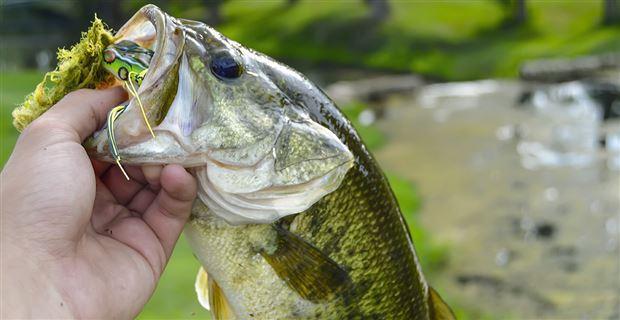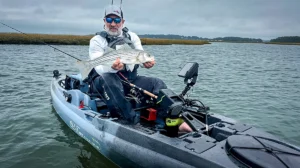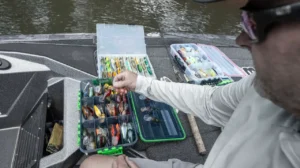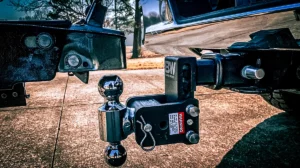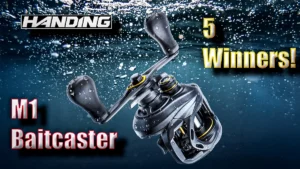I love tournament fishing as much as anyone, and like many others, I do most of my fishing out of a boat these days. With that being said, I still love to walk the shoreline with a handful of fishing rods, looking for the next bite. And fall is one of my favorite times to chase bass from the shore.
In fact, there are times where I’ll welcome bank fishing over taking the time to get the batteries charged, the boat rigged up, and heading off to the lake. If I only have a couple hours of daylight to burn after work, I’d just as soon spend them chasing bass from the bank as opposed to cutting my time in half so I can fish from a boat.
A couple months ago, I relocated from central Illinois to Oklahoma for work purposes, leaving behind all the familiar fisheries. I had probably been moved into my new place all of about 20 minutes before I started thinking about spending the evening wetting a line. Then it hit me: I didn’t know where any good shore fishing spots were.
I was frazzled; me not being able to go fishing is the equivalent of a fish being out of water. I didn’t know anyone from the area, and the options I found from online searches weren’t working out. In the days and weeks that have followed, I’ve fallen back to three tried and true bank-fishing locations:
- Boat Ramps
- Golf Course Ponds
- Bridges
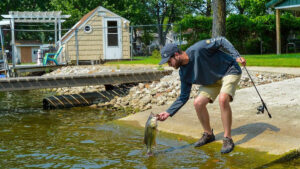
Boat ramps
Like countless other bank anglers, if I really have no clue where I can fish, I am going to head to the closest boat ramp and set up shop. For whatever reason, a lot of folks scoff at fishing near boat ramps from the bank.
Aren’t most boat ramps crowded and don’t they have a lot of commotion? Yep, usually. Isn’t there a lot of fishing pressure at most boat ramps? Not really. Most people blast off and go fish somewhere else.
Boat ramps are great places to find a few bass and several other species of fish, especially as fall settles in across the country.
Boat ramps and the surrounding areas offer everything a transitional bass could want. Deep water in close proximity to shallow water, rock transitions, docks or marinas, and oftentimes a brush pile or two. On top of all that, boat ramps are where many fish get released after small club tournaments. All this adds up to some prime feeding grounds for fish.
I keep it simple as much possible in fishing and stick to a couple different lures that always seem to work for me on and around boat ramps in the fall.
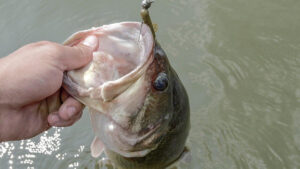
Shaky heads
If I am planning on fishing a boat ramp at any time in the year, I can guarantee you there will be a shaky head in my hand at some point. Unless it is overly windy, I’ll stick to a 1/8 to 3/16-ounce shaky head with a green pumpkin Zoom Trick Worm or Baby Brush Hog threaded on it. There are a myriad of different brands that work great as jigheads, but my favorite is “The Closer” from Custom Cast Lures.
A simple shaky head worm setup will catch fish anywhere in the country. Shake it, drag it, hop it, or sometimes just do nothing on rocks and around docks near the boat ramp. You’ll catch some fish.
Buzzbaits
As we enter the fall transitional period, few lures work better for calling up a big bass than a buzzbait. Baitfish are moving shallower this time of year and a lot of the bass spend their time looking up at schools of shad. Burn and churn something like a War-Eagle Buzzbait over their heads, and you’ll have a good chance of getting the blow-up you crave.
It’s imperative to make long casts paralleling the shore when fishing from the bank with a buzzbait. You keep your bait in the strike zone longer and cover water more efficiently.
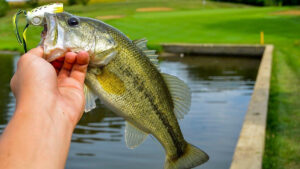
Golf course ponds
Growing up in Central Illinois meant I didn’t have a good grasp on what a “big lake” was. For me, if my Uncle Jeff broke out his 16-foot johnboat with a 25-hp motor on the back, it was a “big boat” that we’d take to the “big lakes.” I learned to fish on farm ponds, strip mines, Illinois lakes that were nothing more than oversized ponds, and walking the banks of golf-course ponds.
Now, before you grab your rods and reels and rush off to the closest golf course, be sure to ask for permission first. Obviously, the first priority of a golf course pond is as a water hazard, not a fishing destination.
Still, I’ve found if you’re willing to be respectful and talk to whoever is in charge of the facilities, you can have yourself an amazing little bank fishing destination. Offer to help with landscaping, to pick up trash, or anything else the grounds keeper needs help with. If volunteering your time will get you fishing rights, it will be well worth it.
You aren’t likely to find the next state record in a golf course pond, but your odds of finding a lot of fish and many times some lone giants that haven’t been pressured are excellent. I can remember losing count of the number of fish we caught on several occasions; the fish were extremely willing to bite simply because no one else had been fishing for them.
Small golf course pond bass are often not conditioned and a lot of lures will work, but I still have my favorites.
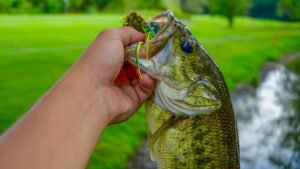
Topwater frogs
From my experience. there is usually a lot of fertilizer runoff that finds its way into these ponds, resulting in a good bit of aquatic vegetation around the edges. Besides vegetation, the edges of these ponds are all too often overrun with frogs themselves.
Making these areas the perfect place to employ your favorite topwater frog. In the fall, it’s hard to beat a SPRO Poppin’ Frog.
Make long casts parallel to the bank; if you’ve got something that will stay on top of the vegetation and loosely mimic ole Kermit hopping on the surface, you are sure to attract some bass in a golf course pond.
Stick worms
Soft stick baits like a Yamamoto Senko or YUM Dinger are staples for fishing these ponds that’ll work all year long. On these fisheries there is no sense getting too complicated with colors; I use green pumpkin or black and blue, and have more success with those two colors than anything else.
Fish the edges of the vegetation and any sticks, stumps, or laydowns you come across. These are also great lures to use as a follow up bait if you have a bass strike and miss your topwater frog. Toss a stick worm to the area you had a strike and more often than not that bass will come back for seconds.
Depending on the fishes mood, you can wacky rig a stick worm, weightless Texas-rig it, or rig a small sinker on top of your Texas-rigged worm; you really can’t go wrong. Just make sure to bring a whole pack of them, as the unpressured pond bass will go through stick worms like candy.
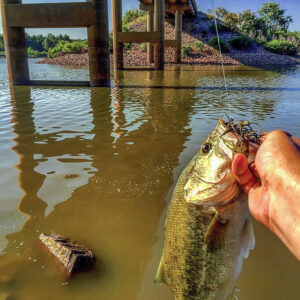
Bridges
The final obvious and easily accessible shore fishing locations I have been capitalizing on lately are bridges. You can find bridges spanning across lakes or rivers in your area, and they’ll hold fish all year long. This holds even more weight during the fall months, when baitfish and bass are on the move.
For the same reasons bridges are sought after locales for boat fishermen, they are opportune spots to spend some time from the bank on. Bridges usually have natural current, relatively deep water, rocks, and create a natural funnel for baitfish and predatory fish alike. Various fish species just live around bridges, or at the very least use them, and bass are no different.
Another positive regarding bridges, all you have to do is look at a map of a lake or river and you can effectively scout your bank fishing destination. This time of year I try to look for as narrow of a bridge as I can find, as long as there is an ample amount of water on each side. If you have a long bridge that crosses right through the middle of a fishery, it’s going to be pretty difficult to fish it from the bank efficiently.
If you have a short and narrow bridge crossing a lake towards the back of a creek arm, you have found a great place to bank fish in the fall. There are several baits you can use to attack bridges.
Jigs
Synonymous with bridges are pilings and rocks. Both of these structures hold bluegills and crawfish, which happen to be hot menu item for bass, and a jig is a perfect imitator of both these forage types. I tend to vary between a 1/2-ounce Strike King Football Jig if I am fishing water deeper than 6 feet, and a 1/4 to 3/8-ounce Missile Jigs Ike’s Mini Flip Jig if I’m targeting skinny water.
Let the water clarity you are fishing decide your color selection. If the water is relatively clear I am going to fish a green pumpkin colored jig. When the water is stained to dirty, I’ll give the reliable black and blue, or brown, more fishing time. Stick a Zoom Super Chunk Jr. on the back of your jig and start casting.
Walking topwaters
The best bridges to fish this time of year are buzzing with baitfish activity. Causing me to reach for my walking baits, like a Zara Spook if the baitfish are large, or a Strike King Sexy Dawg Jr. if the fish on the menu are on the small side.
Fan cast around the pilings, walk your bait parallel to the rock banks around the bridge, and be quick to cast to any surface activity you see. The bites might come in flurries but once you get the action started, it can result in several bass even with your feet planted firmly on the ground.
The cool, comfortable weather fall brings can provide for some of the most enjoyable days of fishing all year. Just because you don’t have a boat, or the time, doesn’t mean you have to miss out on these great fall days of bass fishing.



